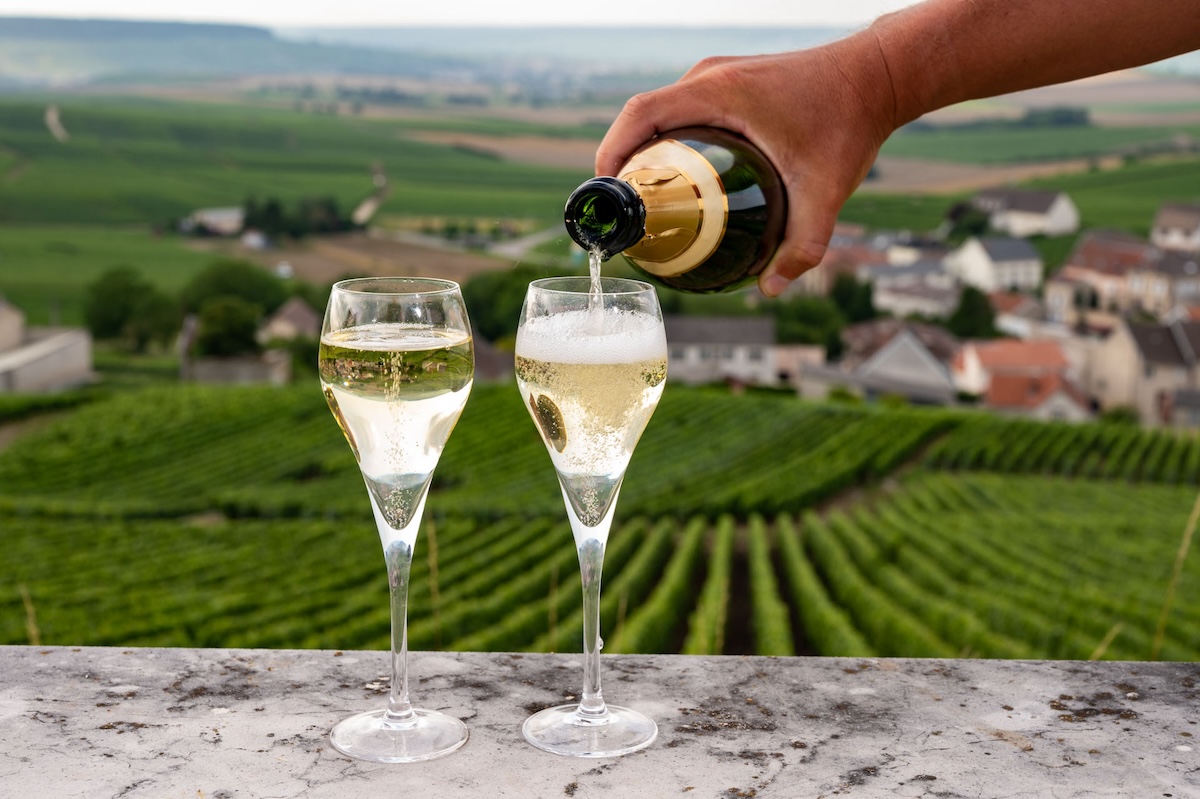Last Updated on December 19, 2025 by Emma Fajcz | Published: April 29, 2024
Are you one of those people that slinks down in your seat when the sommelier of a restaurant is approaching your table, fearing she or he is going to know you’re not the wine pro you wish you were? You’re not alone. The wine world can be very nebulous and intimidating.
But have no fear. For one, most sommeliers are very gentle and also, you can start educating yourself with the basics. Like, for example, what’s the difference between Champagne and wine?
Do you know the difference between Champagne and other sparkling wines like prosecco and cava?
What is wine?
For starters, let’s define what wine is: A fermented alcoholic beverage made with grapes (and sometimes other fruits). With wine, the grapes go through one fermentation process and then are aged in oak barrels (though sometimes the grapes go into steel drums too).
And that’s it. That’s all you need to know. Not really.
Wine making is an art form winemakers have down.
It’s all about the bubbles
The simple answer about the difference between sparkling wine and regular wine is: the bubbles. But like a lot of things, there’s much more going on than just carbonation. The more complex answer is that Champagne falls into a broader type of vino called “sparkling wine.”
Champagne is really just sparkling wine from the region in northeast France which is also called Champagne. It has D.O.P. status, a European Union designation that ensures a certain unique food or beverage actually hails from that particular part of Europe.
Other common D.O.P. products you may have heard about include:
- Parmigiano Reggiano: The famed Italian cheese made in and around Parma in Italy.
- Jamon de Jabugo: A superlative type of cured ham made from 100% Iberian pigs in Andalusia in southern Spain.
- Buffalo mozzarella: The creamy robust cheese made from buffalo milk outside of Naples.
So all Champagne is sparkling wine but not all sparkling wine is Champagne. In Italy, for example, there’s prosecco, produced in the north-eastern part of the country. Emilia Romagna, in north-central Italy, produces lambrusco, a red sparkling wine. Over in Catalonia, they make a sparkling wine called Cava.
D.O.P. products don’t only include wine.
When carbonation was a bad thing
The carbonation happens when the wine re-ferments. In 16th century France, some monks discovered carbonized wine by accident and it was considered a bad thing.
In the 17th century, though, winemakers in northeastern France—including a monk named Don Péignon—started to intentionally carbonize wine by putting the wine under pressure during fermentation so the carbon dioxide (CO2) would be absorbed. The result was a maximum carbonation. And people loved it.
There are two methods of making sparkling wine:
- The traditional method: Which is when the winemaker adds yeast and sugar to the wine when it is first bottled and then adds some extra yeast and sugar during the second fermentation period.
- Then there is the charmant method: First introduced to the world in the early 20th century, which uses a pressurized tank during the second fermentation process rather than a bottle.

The sparkling differences
But not all sparkling wine is created equally:
- Champagne, for example, is made using the traditional method and the wine is made from Pinot Meunier, Pinot Noir, or Chardonnay.
- Cava, the sparkling wine made in the Penedés section of Catalonia, is similar to Champagne in that it is made in the traditional manner but uses Macabeu grapes in a blend of other white grapes. Lately, Spain’s famed wine region Rioja has been getting on the act too, creating their own Cava.
- And then there’s Prosecco, mostly produced in the Veneto, which uses the Charmat method. The majority of the grapes used for Prosecco are of the Glera variety. If you see “spumante” on the bottle, expect maximum carbonation as opposed to “frizzante,” which means it is lighter on the bubble factor.
These are three of the most famous sparkling wines—that also happen to have D.O.P. status and thus, tied to a particular geographic region. The fact is, as you travel around the wine world, you’ll discover a lot of other sparkling wines—from New Zealand and Australia to Napa Valley to the Finger Lakes in New York to Moravia in the southeastern Czech Republic and across the border in northern Austria.

Explore Paris’ Cuisine Like a Local
Join one of our top-rated Paris food tours! With the help of our expert local guides, you’ll get to taste the best of the City of Light and learn about its fascinating culinary history.









